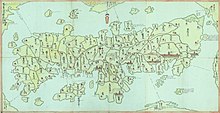Ōhama Domain
 From Wikipedia the free encyclopedia
From Wikipedia the free encyclopedia
The Ōhama Domain (大浜藩, Ōhama-han) was a Japanese domain of the Edo period. It was associated with Shinano Province in modern-day Nagano Prefecture.
In the han system, Ōhama was a political and economic abstraction based on periodic cadastral surveys and projected agricultural yields.[1] In other words, the domain was defined in terms of kokudaka, not land area.[2] This was different from the feudalism of the West.
History
[edit]The domain only existed for a few years. It ended in 1777.[citation needed]
The hereditary daimyō was head of the clan and head of the domain. In Ōhama, the sole daimyō of Ōhama was Mizuno Tadatomo. Tadatomo had been a high-income hatamoto with holdings in the Saku district of Shinano Province He was a page and later an assistant to the 10th shōgun, Tokugawa Ienari.[citation needed] In 1768, Mizuno became a head of the han of over 10,000 koku.[3]
Tadatomo's family was later transferred to the Numazu Domain;[citation needed] and a cadet branch of the Mizuno clan remained at Numazu until the Meiji Restoration.[4]
See also
[edit]References
[edit]
- ^ Mass, Jeffrey P. and William B. Hauser. (1987). The Bakufu in Japanese History, p. 150.
- ^ Elison, George and Bardwell L. Smith (1987). Warlords, Artists, & Commoners: Japan in the Sixteenth Century, p. 18.
- ^ 水野忠友 at Nihon jinmei daijiten – see middle of the page; retrieved 2013-7-11.
- ^ Papinot, (2003). "Mizuno" at Nobiliare du Japon, p. 36; retrieved 2013-7-8.
External links
[edit]- 大浜陣屋 (Ohama jin-ya) at city.hekinan.aichi.jp
- 大浜陣屋 (Ohama jin-ya) at oshiromeguri.com
- 大浜陣屋 (Ohama jin-ya) at geocites.jp